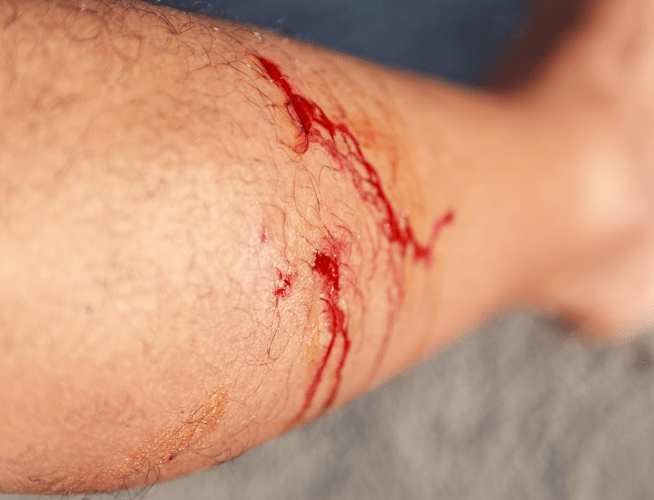
Bite Wounds Are the Most Common Way Rabies Is Transmitted1
The rabies virus is found in the saliva of infected animals. The virus can enter your body when infected saliva penetrates below the skin. Being bitten by a rabid animal is the most common way for this to happen.
Deep wounds may increase the risk of rabies exposure and speed up the spread of the disease. But it’s important to remember that all animal bites, no matter how minor, put you at risk for contracting rabies. This is especially true when it comes to bats.1

Watch Out for Animal Scratches and Other Nonbite Exposures
Bites aren’t the only way rabies is spread. If saliva or brain tissue from an infected animal touches an already open wound—like a scratch or gouge—or contacts your eyes, nose, or mouth, this is considered a nonbite exposure, and you could be infected.1

Bats Are Particularly Dangerous2
Bat bites and scratches may be relatively small. This means they could get overlooked or ignored—and this is the danger. It’s important to remember, any contact with a bat, even very minor wounds like superficial scratches, can cause rabies.1,3
70% of Human Rabies Infections in the US Are Caused by Bats2

Can Humans Give Rabies to Other Humans?
Theoretically, yes. But there are no documented cases of humans passing rabies to other humans the way animals pass rabies to humans.4
There are, however, a few cases where humans have gotten rabies through transplantation. Recipients of corneas, solid organs, and vascular tissue surgically transplanted from patients who died of rabies have contracted rabies and died.1
Find Out What to Do if You Have Been Exposed to the Rabies Virus
Important Safety Information for HyperRAB® (rabies immune globulin [human])
Indication and Usage
HYPERRAB® (rabies immune globulin [human]) is indicated for postexposure prophylaxis, along with rabies vaccine, for all persons suspected of exposure to rabies.
Limitations of Use
Persons who have been previously immunized with rabies vaccine and have a confirmed adequate rabies antibody titer should receive only vaccine. For unvaccinated persons, the combination of HYPERRAB and vaccine is recommended for both bite and nonbite exposures regardless of the time interval between exposure and initiation of postexposure prophylaxis. Beyond 7 days (after the first vaccine dose), HYPERRAB is not indicated since an antibody response to vaccine is presumed to have occurred.
Important Safety Information
For infiltration and intramuscular use only.
Severe hypersensitivity reactions may occur with HYPERRAB. Patients with a history of prior systemic allergic reactions to human immunoglobulin preparations are at a greater risk of developing severe hypersensitivity and anaphylactic reactions. Have epinephrine available for treatment of acute allergic symptoms, should they occur.
HYPERRAB is made from human blood and may carry a risk of transmitting infectious agents, eg, viruses, the variant Creutzfeldt-Jakob disease (vCJD) agent, and, theoretically, the Creutzfeldt-Jakob disease (CJD) agent.
The most common adverse reactions in >5% of subjects during clinical trials were injection-site pain, headache, injection-site nodule, abdominal pain, diarrhea, flatulence, nasal congestion, and oropharyngeal pain.
Do not administer repeated doses of HYPERRAB once vaccine treatment has been initiated as this could prevent the full expression of active immunity expected from the rabies vaccine.
Other antibodies in the HYPERRAB preparation may interfere with the response to live vaccines such as measles, mumps, polio, or rubella. Defer immunization with live vaccines for 4 months after HYPERRAB administration.
Please see full Prescribing Information for HYPERRAB.
You are encouraged to report negative side effects of prescription drugs to the FDA. Visit www.fda.gov/medwatch or call 1-800-FDA-1088
References
- Manning SE, Rupprecht CE, Fishbein D, et al. Human rabies prevention—United States, 2008: recommendations of the Advisory Committee on Immunization Practices. MMWR Recomm Rep. 2008;57(RR-3):1-28.
- Centers for Disease Control and Prevention (CDC). CDC reports increase in human rabies cases linked to bats in the U.S. January 6, 2022. Accessed July 16, 2024. https://www.cdc.gov/ media/releases/2022/p0106-human-rabies.html.
- Crowcroft NS, Thampi N. The prevention and management of rabies. BMJ. 2015;350:g7827.
- Centers for Disease Control and Prevention (CDC). Clinical overview of rabies. Updated June 20, 2024. Accessed July 16, 2024. https://www.cdc.gov/rabies/hcp/clinical-overview/.